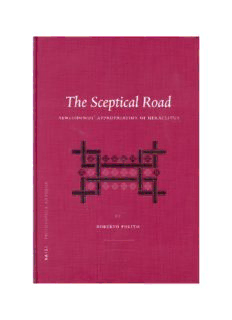Table Of ContentTHE SCEPTICAL ROAD
PHILOSOPHIA ANTIQUA
A SERIES OF STUDIES
ON ANCIENT PHILOSOPHY
PREVIOUS EDITORS
† †
J.H. WASZINK , W.J. VERDENIUS , J.C.M. VAN WINDEN
EDITED BY
K.A. ALGRA, F.A.J. DE HAAS
J. MANSFELD, D.T. RUNIA
VOLUME XCVI
ROBERTO POLITO
THE SCEPTICAL ROAD
THE SCEPTICAL ROAD
aenesidemus’ appropriation
of heraclitus
BY
ROBERTO POLITO
BRILL
LEIDEN•BOSTON
2004
This book is printed on acid-free paper.
Library of Congress Cataloging-in-Publication Data
Polito, Roberto, 1966-
The sceptical road : Aenesidemus’ appropriation of Heraclitus / by Roberto Polito.
p. cm. — (Philosophia antiqua ; v. 96)
Revision of the author’s thesis (Ph. D.)—Cambridge, 1999, originally presented under the
title: Aenesidemus’ interpretation of Heraclitus.
Includes bibliographical references (p. ) and index.
ISBN 90-04-13742-4
1. Aenesidemus, of Cnossus. 2. Heraclitus, of Ephesus. I. Title. II. Series.
B535.A24P65 2004
186’1—dc22
2004043503
ISSN 0079-1687
ISBN 90 04 13742 4
© Copyright 2004 by Koninklijke Brill NV, Leiden, The Netherlands
Cover illustration: Alje Olthof
Cover design: Cédilles/Studio Cursief, Amsterdam
All rights reserved. No part of this publication may be reproduced, translated, stored in
a retrieval system, or transmitted in any form or by any means, electronic,
mechanical, photocopying, recording or otherwise, without prior written
permission from the publisher.
Authorization to photocopy items for internal or personal
use is granted by Brill provided that
the appropriate fees are paid directly to The Copyright
Clearance Center, 222 Rosewood Drive, Suite 910
Danvers, MA 01923, USA.
Fees are subject to change.
printed in the netherlands
For my parents
CONTENTS
Preface ............................................................................................... ix
Introduction ...................................................................................... 1
Part One
KNOWLEDGE
Chapter One The Sources ............................................................... 13
I.1 Diogenes and Aenesidemus (Diog. Laert. 9.106) ............. 13
I.2 Diogenes’ Account of Scepticism ........................................ 20
I.3 Sceptical Literature .............................................................. 24
I.4 The Path (Sext. Emp. PH 1.210) ......................................... 27
I.5 Sextus versus Aenesidemus ................................................. 34
Chapter Two Truth (Sext. Emp. M. 8.8) ........................................ 40
II.1 Appearances ......................................................................... 40
II.2 Agreement ............................................................................ 51
II.3 Heraclitus on Disagreement ............................................... 57
II.4 The Opposites ...................................................................... 59
Chapter Three Scepticism ............................................................... 65
III.1 Reality ................................................................................... 65
III.2 Nature ................................................................................... 69
III.3 Sensation .............................................................................. 72
III.4 Medical Empiricism ............................................................. 78
III.5 The Tropes ........................................................................... 82
III.6 Sense-Perception .................................................................. 89
III.7 Intellect ................................................................................. 93
III.8 Sceptical Arguments ............................................................ 97
viii contents
Part Two
THE SOUL
Introduction ...................................................................................... 105
Chapter Four: Soul and the Body .................................................... 108
IV.1 The Ruling-Part-of-the-Soul
(Sext. Emp. 8.349; Tert. DA 15) .......................................... 108
IV.2 Mind and the Senses (Sext. Emp. 8.350; Tert. DA 14) ...... 119
IV.3 The ‘Channels’ of Sensation ............................................... 130
IV.4 The Substance of the Soul (Tert. DA 9) ............................. 139
Chapter Five: Sextus on Heraclitus (M.7.126-134) ........................ 149
V.1 The Criterion of Truth ........................................................ 149
V.2 Sextus and Aenesidemus ..................................................... 156
V.3 Interpreting Heraclitus ........................................................ 165
V.4 Common Reason ................................................................ 169
Conclusion ......................................................................................... 173
Appendices
Time (Sext Emp. M10.216-218) .................................................. 180
Motion (Sext. Emp. M. 10.38) ..................................................... 190
Bibliography ...................................................................................... 193
Index .................................................................................................. 198
PREFACE
This book is a revised and expanded version of my Cambridge Ph. D.
dissertation ‘Aenesidemus’ Interpretation of Heraclitus’, submitted
in 1999. Gratitude is due, above all, to my Ph.D. supervisor in Cam-
bridge, David Sedley, for his continuous advice and support. No less
gratitude I express to Fernanda Decleva Caizzi, who supervised my
Milanese Tesi di Laurea, in which I first encountered what was to
become the subject of this book. The book has also benefited from
the useful comments which I received from Geoffrey Lloyd, Malcolm
Schofield, Miles Burnyeat, Gisela Striker and Tony Long. I also would
like to thank the Brill anonymous referee for her/his comments.
None of them, however, should be assumed to agree with the views
expressed in this book. Regrettably, not all works on ancient Scepti-
cism which came out after 1999 could be discussed as extensively as I
wished.
An English translation of the testimonia (the Loeb, when available,
with changes) is provided in the main text. Greek (or Latin) texts can
be found in the footnotes. Greek and Latin key words are sometimes
left in their original, depending on the argument’s requirement.
Heraclitus’ fragments are referred to according to Diels-Kranz’s num-
bering of them; Galen’s works are referred to according to the Kühn
edition (when available), or according to the authoritative one.
During the years of work, either doctoral or post-doctoral, which
the book incorporates, I benefited from the financial help of (reverse
chronological order): the Center for Hellenic Studies, Washington
DC; the Accademia Nazionale dei Lincei, Rome; the Faculty of
Classics, Cambridge; St. John’s College, Cambridge; the Philosophy
Department of the Università degli Studi of Milan.
Description:The revival of Scepticism in the first century B.C. is due to Aenesidemus of Cnossus. Nonetheless, very little is known of him, and much of it seems to suggest that his thought tended more towards Dogmatism, and Heraclitean philosophy in particular. The puzzle has set the scene for a long-term debat

